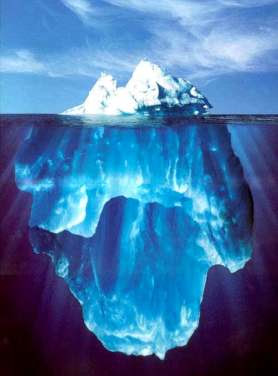Antarctica's Glaciers Cracked due to Global Warming.
NASA DATA. February, 2012. NASA's Terra Earth-observing satellite captured this image of Pine Island Glacier in West Antarctica last November 2011, after a research team discovered a huge 19-mile (30 km) long crack running across it.
Members of the Operation Ice Bridge mission spotted the crack during a DC-8 flight over Pine Island Glacier (PIG). It's estimated to be up to 260 feet (80 meters) wide, and 195 feet (60 meters) deep.
The crack will eventually shear the glacier off completely, creating an ice island spanning 350 square miles (900 sq. km.)
The Pine Island Glacier is a major ice stream that drains 10 percent of the entire West Antarctic Ice Sheet. Although a warming climate and warmer seas have affected glaciers elsewhere in Antarctica, calving events like this have been happening steadily on PIG over the past few decades, at least.
"It's part of a natural cycle, but it's still very interesting and impressive to see up close," said Ice Bridge project Scientist Michael Studinger. "It looks like a significant part of the ice shelf is ready to break off." Due to fuel supply issues Operation Ice Bridge was forced to cancel their last flight, departing Antarctica in November 2011. Nevertheless the mission was a success, providing Scientists with valuable on ice thickness and trends affecting global sea-level rise..., even if a few cracks were discovered along the way.
Published in February 2012.
Massive crack was discovered in ice shelf. NASA's Operation Ice Bridge discovers a major rift in Western Antarctica, which could produce an iceberg more than 800 square kilometers in size in the near future. The location of Antarctica is at the end of the world in South America.
American Scientists and Russian Scientists have been working together in these kind of projects for so long. In fact, powerful countries used to perform thermal-nuclear explosions in Antarctica during the post-war, II World War, as experiments. Can you imagine the eventual damage that humans inflicted to our precious natural environment?...
With a gargantuan crack slowly splitting it apart, Antarctica's fastest-melting glacier is about to lose a chunk of ice larger than all of NEW YORK CITY, Scientists say...
Snaking across the floating tongue of the Pine Island Glacier in West Antarctica, the crack is expected to create an iceberg 350 square miles (907 square kilometers), versus 303 square miles (785 square kilometers) for Manhattan, Brooklyn, Queens, Staten Island, and The Bronx combined, according to NASA.
"Glacier is Contributing Most to Sea Level."
Glaciers that flow into the sea, like the Pine Island Glacier, go through a normal cycle in which the floating section grows, stresses mount, and an iceberg breaks off, Ted Scambos said. He is a Glaciologist of the National Snow and Ice Data Center (NSIDC) in Boulder, Colorado, USA.
But when the pattern deviates, Glaciologists take notice. In this case, the crack is forming significantly farther "upstream" than has previously been the case. That "signifies that there are changes in the ice," he said. When "that point of rifting starts to clim upstream, generally you see some acceleration of the glacier." That means the ice will flow into the ocean at a faster rate, contributing even more to sea level rise.
Hundreds of Glaciers are Melting Faster in Antarctica due to Global Warming.
Such an acceleration is of particular concern at the Pine Island Glacier, because among Antarctic Glaciers, it's "the one that's contributing the most to sea level rise."
In fact, he said, ice flows from that glacier alone account for a quarter to a third of Antarctica's total contribution to sea level rise.
"It's moving at about three kilometers, almost two miles per year," Scambos said. He noted, "it's been accelerating quite a bit."
Cracking Glacier is Really Important.
"West Antarctica has ice streams, of which Pine Island is one. Those are fast-flowing streams of ice," said Oceanographer Doug Martinson of Columbia University's Lamont-Doherty Earth Observatory, who specializes in Polar Oceans.
When ice breaks off the Pine Island Glacier, he said, more ice can flow in faster from the mountains above, ice that will eventually wind up contributing to sea level rise.
I personally think that humans have been contributing to Global Warming, especially since the beginning of the 20th Century. Who is responsible for the breaking of The Ozone Layer? I wonder...
I personally think that the world, and we -humans- will eventually enter into The Last Days, just like Prophets in The Revelations Chapter of The Holy Scriptures had announced thousands of years ago...
We should not forget the nuclear experiments that were performed in The Marshall Islands, especially in the Bikini Atoll after the II World War. The permanent damage in the natural environment is clearly visible. The Ozone Layer on Planet Earth was broken back then...
Greenhouse effects, heavy pollution in the air and water, thermal-nuclear explosions used during the 20th Century, and nuclear energy floating on the Earth's surface and atmosphere caused Mega Damages Worldwide. What do you think about these facts?? I wonder...
HAVE A BLESSED TIME!!
POET STARRY DAWN.









































